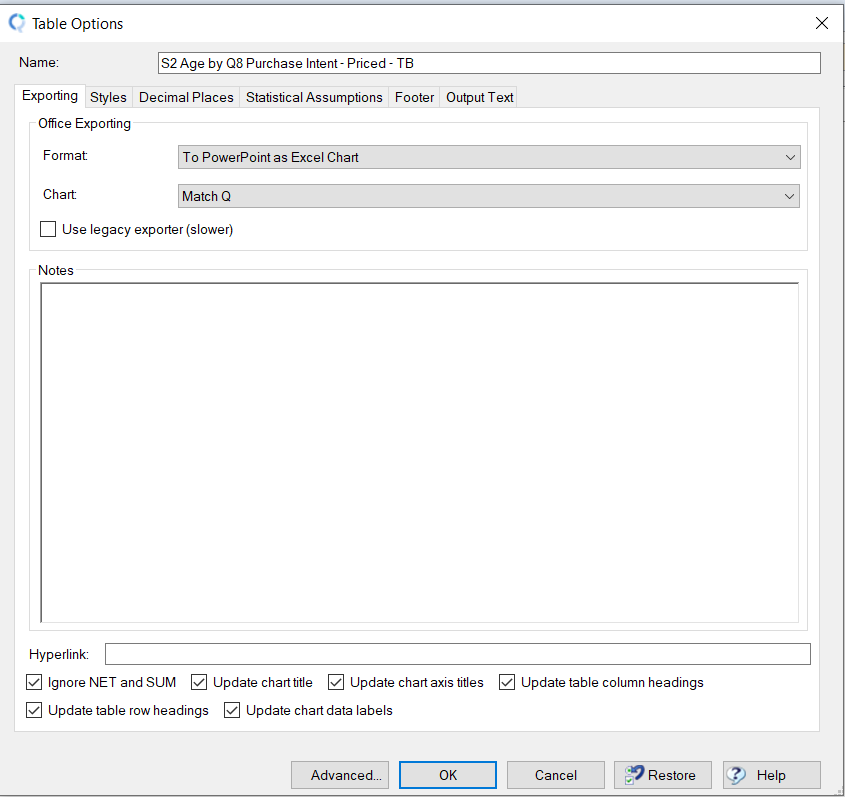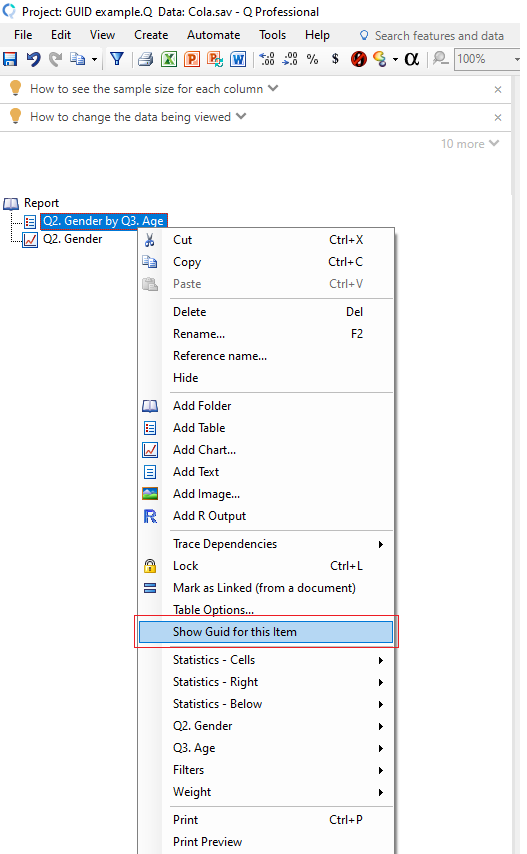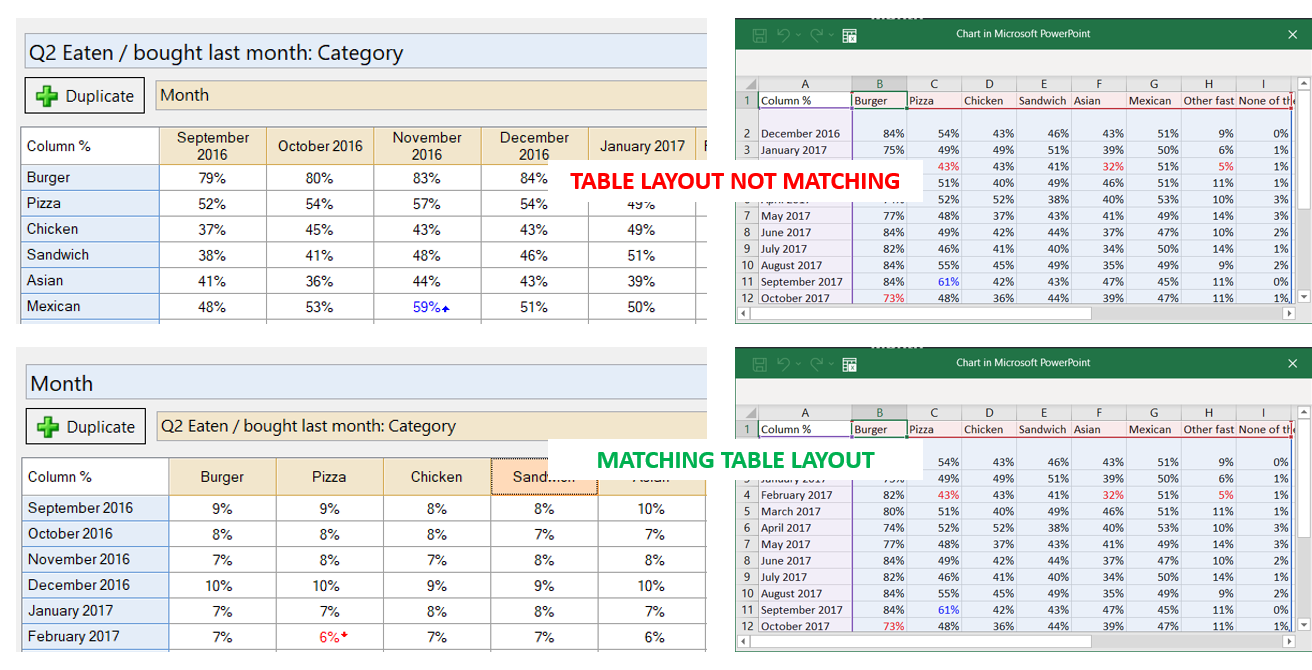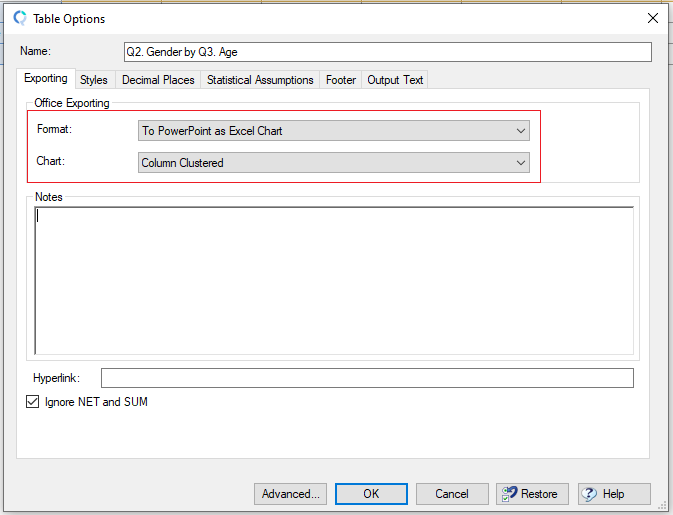Exporting to PowerPoint
| Related Videos | |
|---|---|
|
All parts of Working With PowerPoint (Video)  |
Q can automatically export charts, tables and text to PowerPoint and update the PowerPoint presentation to reflect updates of data in Q.
The underlying programming for how this is done is changing with the introduction of Q version 5.12, building on changes made in Q5.11. The default is now to export to a named file, which is faster and more stable than the previous exporting method (which is still available, as a “legacy” export option).
You can check the version of Q you have installed by going to the Help menu and selecting About. Contact Support for further information.
Exporting to PowerPoint Q version 5.12 or later
To export a selected output from Q to PowerPoint you can either click on the PowerPoint export icon ![]() , or by right-clicking on the Q output > | Export to Office > Export to PowerPoint.
, or by right-clicking on the Q output > | Export to Office > Export to PowerPoint.
A Table Options dialog box appears, where you can select the desired Format and Chart type. Outputs can be exported as Images, or editable Tables or Charts.
Export editable charts to PowerPoint
In the table options menu, set the Format To PowerPoint as Excel Chart and select the desired chart type from the Chart menu. There is a new Chart option, Match Q, which when selected, charts will export as per the current chart type set in Q and tables exported as charts will be as per the settings in Q’s “User Options”. To access the previous PowerPoint exporter (the default in earlier version of Q), tick the “Use legacy exporter (slower)” checkbox. This exports outputs to an open PowerPoint document. As the label suggests, this method is slower and is also less stable.
Update an existing PowerPoint document
Charts, tables and images exported from Q to a PowerPoint document are linked back to Q and can be updated. Note: this feature is not available when exporting format is set to To PowerPoint as Microsoft Graph.
This feature is particularly useful for updating reports for tracking studies. However, it has numerous other uses such as updating a specific output or report after applying a different filter (e.g. country), changing the weighting, adding a cross-break, merging answer codes or adding a net, to name just a few.
To update a chart exported from Q click on the PowerPoint Export icon ![]() or by right-clicking on the output > Export to Office > PowerPoint. Select the file you wish to update. For the first update, Q will preserve the original file (so you always have a back-up of your original export) and create a new file with a filename you nominate, the content of which will be updated to reflect any changes done in Q. For second and subsequent exports, the new file (if selected) will be over-written, to avoid cluttering the directory with files, but Q will keep a back-up of the previous updated file (*.pptxBak).
See also: Automatic Updating of PowerPoint and Excel Documents – Q5.12 and later.
or by right-clicking on the output > Export to Office > PowerPoint. Select the file you wish to update. For the first update, Q will preserve the original file (so you always have a back-up of your original export) and create a new file with a filename you nominate, the content of which will be updated to reflect any changes done in Q. For second and subsequent exports, the new file (if selected) will be over-written, to avoid cluttering the directory with files, but Q will keep a back-up of the previous updated file (*.pptxBak).
See also: Automatic Updating of PowerPoint and Excel Documents – Q5.12 and later.
You can now customize what is sections of the table and charts are updated using the checkboxes in the picture above. You may have made some custom edits on an output in PowerPoint that you want to preserve – to do this simply uncheck the relevant item prior to exporting.
Updating is based on GUIDs
Every object that can be updated from Q has a GUID (Globally Unique Identifier code) assigned to it. To see the GUID right-click on the output and select Show GUID for this Item.
GUIDs are recorded in the PowerPoint Alt Text field
In order for Q to update an object in PowerPoint, it is necessary to record the GUID in the Alt Text field in PowerPoint. This field is accessed in PowerPoint by right-clicking on the object (e.g., a chart), and selecting Edit Alt Text.....
Connecting PowerPoint charts to Q
To connect a chart created in PowerPoint to an output created in Q select the output in Q > right click > Show GUID for this Item. You can select the GUID by using your mouse and clicking and dragging over it. It can be copied by right-clicking and selecting Copy. In PowerPoint right-click on the object > Edit Alt Text.... > CTRL+V (paste). The object in PowerPoint is now connected with Q and can be updated.
In order for PowerPoints outputs such as charts to update correctly, it's important to ensure that the layout of the data tables in Displayr and in the PowerPoint chart match – that is that the rows and columns of tables are positioned in the same way. To check the required layout, open your PowerPoint document > select the chart > right-click > Edit data. If the layout of the table doesn't match go back to Q, select the table, right-click on either row or column heading and select Swap rows and columns.
Charts
PowerPoint Charts
All of the standard Microsoft Office chart types can be exported and updated using Q, where 'standard' refers to the chart types that are selectable within PowerPoint, Excel and Word's Chart Type menus.
PowerPoint Chart Templates
Within Microsoft Office it is possible to automatically format charts using Chart Templates. These Chart Templates can be selected when exporting from Q (see Export to Office).
Export Chart Defaults
Office Chart Types and Office Chart Templates can be set as defaults for particular combinations of data using Edit > User Options > Export Chart Defaults.
Q's Charts
Q's Charts have been specifically designed for market research. In particular, they can display the results of tests of statistical significance.
Chart Templates
Any chart can be saved as a template using View > Save as Template. These templates can then be selected from the Show Data as menu (see Charts for more information).
General defaults
Default fonts, font sizes, font styles chart colors can be set at Edit > Project Options > Customize > Charts.
Tables
Image of Table
When exporting To PowerPoint as Image of Table, the general appearance of the table is controlled via Table Styles.
PowerPoint Table
When exporting To PowerPoint as PowerPoint Table, the general appearance of the table is controlled via settings in PowerPoint. The default table style comes from the Theme of the slideshow. You can change this default by right-clicking on your desired table style in the Table Style gallery of the DESIGN tab of the ribbon (you will need to manually change the first table).
Significance Arrow Highlights on Tables
Exported PowerPoint tables will no longer have scalable significance arrows. Arrows have changed from the symbol font representation to Unicode Black up/down pointing triangles, which makes for easier updating.
Slide Layout
PowerPoint Templates
When using the legacy exporter …
The major aspects of the layout of a slide are determined by the settings within PowerPoint files, which are, in turn, controlled by PowerPoint templates and PowerPoint's Master Slide settings.
When using the new default (fast) export …
When creating a new file, Master slides will export titles center aligned (This matches Q’s master pages but not PowerPoint’s default). When updating an existing file, titles will follow the settings in the PowerPoint file.
PowerPoint Export Layout
Additional control over the appearance of exports in PowerPoint is available within Q via the PowerPoint Export Layout settings.
Table Sizing
When using the legacy exporter …
By default, large tables are shrunk to fit into the available space. This can be turned off by selecting User Options > Display/Printing and de-selecting Shrink tables to fit in one slide (when exporting to PowerPoint) or in page margins (when exporting to Word).
When using the new default (fast) export …
Tables will scale to fit the available space. If the table is large (e.g. more than 20 rows) font sizing will make it hard to read so you will need to make some adjustments to enhance legibility
Exporting to PowerPoint Q version 5.11
To export a selected output from Q to PowerPoint you can either click on the PowerPoint export icon ![]() , or by right-clicking on the Q output > | Export to Office > Export to PowerPoint.
, or by right-clicking on the Q output > | Export to Office > Export to PowerPoint.
A Table Options dialog box appears, where you can select the desired Format and Chart type. Outputs can be exported as Images, or editable Tables or Charts.
Export editable charts to PowerPoint
In the Table options menu, set the Format to To PowerPoint as Excel Chart and select the desired chart type from the Chart menu.
Update an existing PowerPoint document
Charts, tables and images exported from Q to a PowerPoint document are linked back to Q and can be updated. Note: this feature is not available when exporting format is set to To PowerPoint as Microsoft Graph.
This feature is particularly useful for updating reports for tracking studies. However, it has numerous other uses such as updating a specific output or report after applying a different filter (e.g. country), adding a cross-break, merging answer codes or adding a net, to name just a few.
To update a chart exported from Q click on PowerPoint Export fast icon ![]() or by right-clicking on the output > Export to Office > PowerPointFastUpate.
or by right-clicking on the output > Export to Office > PowerPointFastUpate.
Select the file you wish to update. Q will create a new file, the content of which will be updated to reflect any changes done in Q. Q will save the file in the same folder alongside the original file, adding a consecutive number to the name (e.g. Export(1).pptx).
Updating is based on GUIDs
Every object that can be updated from Q has a GUID (Globally Unique Identifier code) assinged to it. To see the GUID right-click on the output and select Show GUID for this Item.
GUIDs are recorded in the PowerPoint Alt Text field
In order for Q to update an object in PowerPoint, it is necessary to record the GUID in the Alt Text field in PowerPoint. This field is accessed in PowerPoint by right-clicking on the object (e.g., a chart), and selecting Edit Alt Text.....
Connecting PowerPoint charts to Q
To connect a chart created in PowerPoint to an output created in Q select the output in Q > right click > Show GUID for this Item. You can select the GUID by using your mouse and clicking and dragging over it. It can be copied by right-clicking and selecting Copy. In PowerPoint right-click on the object > Edit Alt Text.... > CTRL+V (paste). The object in PowerPoint is now connected with Q and can be updated.
In order for PowerPoints outputs such as charts to update correctly, it's important to ensure that the layout of the data tables in Displayr and in the PowerPoint chart match – that is that the rows and columns of tables are positioned in the same way. To check the required layout, open your PowerPoint document > select the chart > right-click > Edit data. If the layout of the table doesn't match go back to Q, select the table, right-click on either row or column heading and select Swap rows and columns.
Exporting to PowerPoint - Q up until and including version 5.10
Charts
Q can either create standard PowerPoint charts at the time of export, or, export its own internal Charts.
| PowerPoint Charts | Q Charts |
|---|---|
| Data can be edited and viewed | Can display significance tests |
| More extensive formatting options | Developed specifically for market research |
PowerPoint Charts
All of the standard Microsoft Office chart types can be exported and updated using Q, where 'standard' refers to the chart types that are selectable within PowerPoint, Excel and Word's Chart Type menus.
PowerPoint Chart Templates
Within Microsoft Office it is possible to automatically format charts using Chart Templates. These Chart Templates can be selected when exporting from Q (see Export to Office).
Export Chart Defaults
Office Chart Types and Office Chart Templates can be set as defaults for particular combinations of data using Edit > User Options > Export Chart Defaults.
Q's Charts
Q's Charts have been specifically designed for market research. In particular, they can display the results of tests of statistical significance.
Chart Templates
Any chart can be saved as a template using View > Save as Template. These templates can then be selected from the Show Data as menu (see Charts for more information).
General defaults
Default fonts, font sizes, font styles chart colors can be set at Edit > Project Options > Customize > Charts.
Tables
Image of Table
When exporting To PowerPoint as Image of Table, the general appearance of the table is controlled via Table Styles.
PowerPoint Table
When exporting To PowerPoint as PowerPoint Table, the general appearance of the table is controlled via settings in PowerPoint. The default table style comes from the Theme of the slideshow. You can change this default by right-clicking on your desired table style in the Table Style gallery of the DESIGN tab of the ribbon (you will need to manually change the first table).
Slide Layout
PowerPoint Templates
The major aspects of the layout of a slide are determined by the settings within PowerPoint files, which are, in turn, controlled by PowerPoint templates and PowerPoint's Master Slide settings.
PowerPoint Export Layout
Additional control over the appearance of exports in PowerPoint is available within Q via the PowerPoint Export Layout settings.
Shrink tables to fit one slide
By default, large tables are shrunk to fit into the available space. This can be turned off by selecting User Options > Display/Printing and de-selecting Shrink tables to fit in one slide (when exporting to PowerPoint) or in page margins (when exporting to Word).
Footers can be extensively customized. See Footers.





